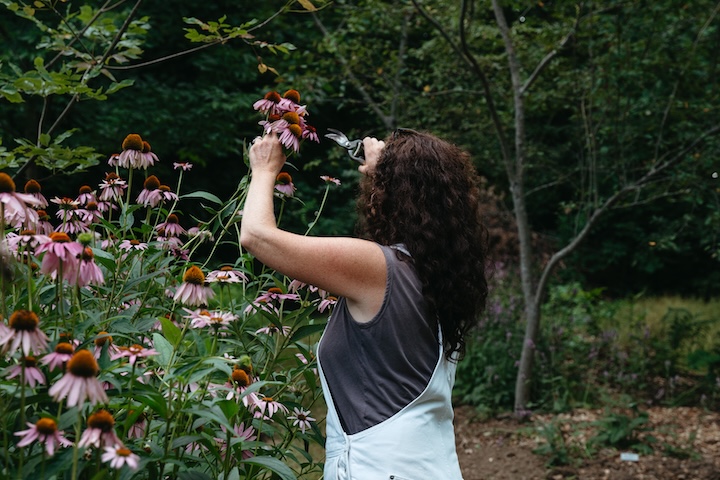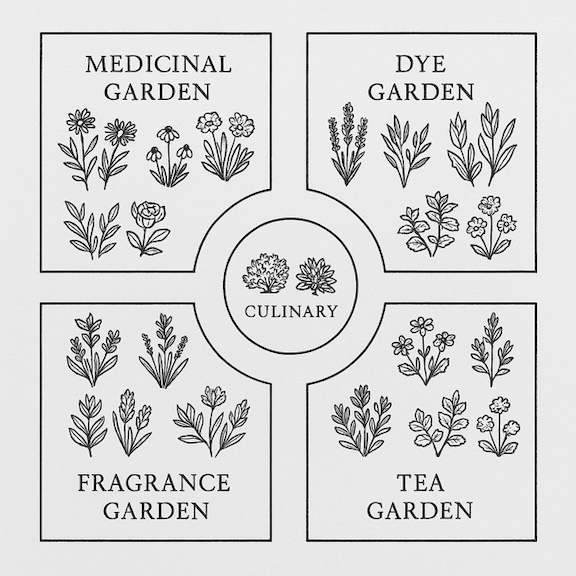By Emily Springer
One of my favorite pastimes is dreaming up new herb gardens. Just ask my husband and kids, who patiently help bring those dreams to life each season. Over the years at Meeting House Farm, I’ve experienced both glorious successes and some humbling flops. I want to share four tenets of herb garden planning that have served me well — and I hope they’ll inspire you to create a garden that’s both beautiful and purposeful.
- Start with the Site
When you’re planning a new garden from scratch, you have the luxury of intentionally choosing the perfect location. Most herbs thrive in full sun, which means 6-8 hours of direct sunlight per day. In general, herbs prefer loamy, well-drained soil and rarely need fertilizer. Pay attention to the drainage as well as the soil of the site you select. Even raised beds cannot fully compensate for a site that is waterlogged or full of clay. While each plant has its own specific preferences, you’ll have the most success if you select a site that meets these general needs.

In my mind, herb gardens are meant to be peaceful sanctuaries. Choose a private, quiet space if you can. And if you’re just getting started, find a spot where you can begin small and expand over time.
If you’re working with an existing garden, your layout may be more constrained. In that case, choose the sunniest area with the best soil and amend it as needed. Many herbs are surprisingly forgiving once they’re established.
At Meeting House Farm, we use a combination of raised beds and in-ground no-till beds. Our raised beds were originally part of our kitchen garden and have since been transitioned into herb production.
Our no-till method is simple and effective: Lay down clean cardboard (no tape or ink), add at least 6 inches of compost, and top with up to 3 inches of deciduous wood chips. (Leaf mulch also works, but beware — it often contains maple seeds, which make for a lot of extra weeding!) The cardboard will break down within about three months.
While this method is best done in the fall for spring planting, I’ve had success planting just two weeks after creating the bed. By the time the seedling roots reach the cardboard, it’s soft and pliable.
A note on what’s under the cardboard: We’ve had great success simply mowing whatever’s in the space where we intend to plant, then laying the cardboard on top. This has even worked for brambles. The cardboard helps create conditions for the plants that were there to break down, setting the stage for healthy soil life.
If you’re building raised beds, use untreated cedar or hemlock, or go with stone or brick for borders. For our contained beds, our go-to soil mix is 50% organic compost and 50% of a combination of vermiculite, sustainably harvested peat moss, sand, blood meal, wood ash, leaf mold, and bone meal — a blend that feeds plants and drains well.
2. Design with Intention
Herb gardens have long been part of kitchen gardens, particularly in European traditions. Culinary herbs were often planted near the kitchen door, while medicinal herbs had their own space nearby. At Meeting House Farm, we’ve embraced this spirit with a culinary herb circle near our kitchen and larger production fields devoted to medicinal plants.
When I design an herb garden, I always begin with its purpose. Are you dreaming of a calming tea garden? A healing apothecary? A fragrant space for reflection? A buffet for pollinators? Your purpose will guide your design.
If you have plenty of space, consider a traditional quadrant layout — a square garden divided into four sections, each dedicated to a specific category, such as dye herbs, medicinal herbs, culinary herbs, and tea herbs. This classic format is both functional and beautiful.

Another layout we teach at Meeting House Farm is the Grow Your Own Apothecary design. It offers a curated selection of herbs that are easy to grow, multi-functional, and supportive of both people and pollinators. This design is a border garden — a long, relatively narrow layout ideal for planting along a fence or wall. The front edge of the bed can be either straight or gently curved, depending on your preference. Plants are grouped in clusters of three for visual harmony and practical harvesting. The design leans towards symmetry: For example, if three calendula plants are placed on one side, a matching trio is mirrored on the other. Arrange plants by height, placing the shortest varieties in the front and the tallest towards the back.
3. Choose Your Plants Thoughtfully
When planting a garden with purpose, choose herbs that are multi-use, relatively easy to grow, and “well-behaved.” I define “well-behaved” as herbs that won’t take over your garden or self-seed aggressively across your entire yard. That said, many herbs do gently self-seed in place — I consider that a gift.
You’ll also need to consider your growing zone. Most of Maine is either Zone 5 or 6. If you’re reading this further south, you may have more flexibility in the plants you select. The plants I suggest below thrive in Maine’s conditions.
Whenever possible, choose perennials. They reduce your annual planting workload and allow your garden to become more established and beautiful over time. Include a few annuals to round out your collection, but let perennials form the backbone.
Also consider beauty — all gardens should bring beauty into your life, whether through fragrance, flower, form, or the quiet joy of a hummingbird hovering near a bloom.
Here are some of my go-to plants — many appear in more than one of the categories below. Choosing multipurpose plants is always beneficial in an herb garden.
Medicinal Plants
- Anise hyssop — perennial; supports pollinators.
- Calendula — annual; supports pollinators.
- Elecampane — perennial.
- Echinacea — perennial; supports pollinators.
- Lavender — perennial; supports pollinators (Lavandula angustifolia ‘Krajova’ does best in Maine).
- Roman chamomile — perennial.
- Rose — perennial; gallica varieties support pollinators (ornamental roses, not so much).
- Solomon’s seal — perennial (yes, full sun is fine).
- Tulsi/holy basil — annual (in Maine); supports pollinators.
Culinary Herbs
- Basil — annual.
- Mint — perennial (keep in a pot — it spreads!).
- Parsley — biennial, supports pollinators.
- Rosemary — annual (in Maine).
- Sage — perennial; supports pollinators.
- Thyme — perennial; supports pollinators.
Dye Plants
- Calendula — annual; supports pollinators.
- Indigo — annual.
- Madder — perennial.
- Yellow iris — perennial.
Fragrant Herbs
- Clary sage — biennial.
- Lavender — perennial; supports pollinators (‘Krajova’).
- Nicotiana — annual.
- Rose — perennial; gallica varieties support pollinators.
- Rose geranium — annual (in Maine).
Herbs for Tea
- Lavender — perennial; supports pollinators (‘Krajova’).
- Lemon balm — perennial; supports pollinators.
- Lemon verbena — annual (in Maine).
- Mint — perennial.
- Roman chamomile — perennial.
- Tulsi/holy basil — annual (in Maine); supports pollinators.
4. Lay It Out
Once you’ve selected your plants, it’s time to bring your design to life. When planning your layout, keep in mind the full-grown size of each plant. I personally love a full garden — not only is it lush, but it leaves less space for weeds. A good rule of thumb is one plant per square foot. This is general advice, but it will serve you well in most cases.
If your garden uses a border design, like the one described above, place shorter plants at the front and taller ones at the back. If you’re designing a garden meant for wandering, place the tallest plants in the center of each bed and work outward to smaller ones along the edges.
Plant your herbs in groups of three for visual harmony and easier harvesting. If I’m planting several beds within a garden, I try to bring symmetry between the beds. For example, I might incorporate a rose bush in two of the beds and place them diagonally across from each other. I might also add Czech lavender (Lavandula angustifolia ‘Krajova’) at the corners of each bed to bring continuity. You can do this with repeated plants or with colors.
When I’m laying out a new bed, I often make a string grid to guide spacing. To make a grid, place a stick in the soil every 12 inches along both ends of the bed. Repeat the process along the adjacent edges, then tie twine between the sticks to form a crisscross pattern close to the ground. This simple setup provides a visual guide for even planting and is especially helpful if little ones are lending a hand.
That said, don’t let perfection keep you from getting started. If the grid feels like too much, simply place your plants on the soil, step back, make any adjustments, and plant when it feels right.
For best results, plant on a cool or foggy day. If you need to plant during hot weather, water your herbs thoroughly before and after planting. They’ll need daily water until established — plan on at least a month.
A Word on Sourcing Your Plants
If you’re building an herb garden for healing, pollinators, or natural dyeing, seek out non-hybridized varieties — these offer the richest medicinal and ecological value. Most garden centers don’t carry many of these plants.
For organic herbs and seeds, I recommend:
- Fedco Seeds.
- Milkweed Farm.
- Meeting House Farm.
- Strictly Medicinal Seeds.
Whether you’re planting your first herbal garden or redesigning a beloved patch of earth, remember this: An herb garden is more than just a collection of plants, it’s a place to nourish your body and spirit, to heal, to dream, and to connect with the rhythms of nature. May your garden bring you beauty, bounty, and the quiet satisfaction of planting with purpose.
For more information about herb garden design, the Herb Growers Collaborative, or to purchase plants and dried botanicals, visit meetinghouse.farm or email [email protected].
Emily Springer is the founder of Meeting House Farm, the national herb growers collaborative. Her mission is to is teach others how to grow healing gardens and connect farms with communities seeking fresh, local, and high-quality herbs.
This article was originally published in the summer 2025 issue of The Maine Organic Farmer & Gardener.